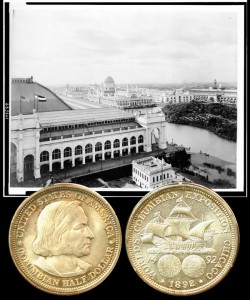Today, the World’s Columbian Exposition Silver Half Dollar Coin remembers the snow, ice and heavy rain of January 1893 and the damage to the exhibition buildings.
First, the Ottawa [IL] Free Trader included a brief description in their newspaper:
=====
Hundreds of feet of the annex roof of the manufactures building were crushed beneath the weight of avalanches of snow and ice, and damage to the extent of many thousands of dollars entailed yesterday.
Other World’s Fair buildings were more or less damaged, and the progress of the thaw is being watched with keen anxiety by the heads of departments and their assistants.
Nearly every hour of the day has added something new to the extent of the disaster.
=====
A couple of weeks later, the Metal Worker [magazine] of February 1893 included a less dramatic description of the snow damage:
=====
On the 28th ult. considerable damage was done to some of the roofs of the large buildings by accumulations of snow, which formed avalanches under the effect of a heavy rain.
The frame work of the roofs was not injured in the least, having been built to withstand almost any strain short of an earthquake.
Skylights and glass work suffered, as they could not be braced against such an accident as a snow slide.
An erroneous impression has prevailed that the roofs themselves did not bear the weight of the snow.
The Manufactures Building is constructed in what might be considered three sections. First there is a main portion 376 feet wide with a towering roof several hundred feet high.
On either side of this are annexes or naves, much lower, 175 feet wide. It was on the great height of the main roof that the snow accumulated.
There are at least 16 acres of space there, and the great fall of snow in the last few weeks steadily accumulated.
When the mild weather came on, accompanied by rain, the 16 acres of snow became saturated with moisture.
As the rain continued the burden became heavier, and finally the great mass of wet snow slipped from its moorings and started on the down grade.
For 200 feet it had a clear track and acquired a great momentum. Then it had a clear jump of 50 feet to the glass roof below. Thither it fell and crashed everything before it.
The curve in the main roof gave even a greater fall, and apparently the snow left its base of support on reaching this curve and made a sheer jump of nearly 100 feet.
Of course nothing in the way of the ordinary roof structure could withstand the shock.
But to repair damages will only cost $5000, which proves that it was not a very serious matter.
The injury to other roofs was of the same character but even less serious.
=====
The Inland Architect of August 1893 included a description of the engineering for the Manufactures building’s roof.
=====
The arches over the court of the Manufactures and Liberal Arts building were figured for a vertical load of 42 pounds, made up as follows: iron 20, roof 10, snow 12.
A recalculation made after the roof was completed, taking shipped weight of iron, showed weight of iron on straight part of roof to be 22.5 pounds; roof 8 pounds, leaving 11.5 pounds for snow.
The arches were also figured to withstand a wind pressure of thirty pounds per square foot, acting horizontally against the wooden structure which surrounds the court, concentrated at that point of the arch where the combination truss is connected to it.
It amounted to 90,000 pounds at this point, seventy-six feet above the bottom pin.
In addition to this a wind pressure of thirty pounds per square foot was taken, acting at an angle of twenty degrees with the horizon, extending over the whole roof.
For the combined strain from wind, dead and snow load, the unit strain was taken at 30,000 pounds per square inch.
The connections, however, were made fifty per cent stronger than this.
The specifications sent to bidders on these arches called for either Bessemer or open-hearth steel not to contain over .08 of 1 percent of phosphorus; to have an ultimate strength of not less than 66,000 nor more than 74,000 pounds, with an elastic limit of not less than 37,000 pounds; an elongation of not less than sixteen percent in eight inches, and a reduction of not less than twenty-five per cent at point of fracture.
Over 3,500 tests of this material were made by Messrs. Estrada, Kenyon & Gray, the inspectors, with the following average results:
Elastic limit, 40,000 pounds; elongation in eight inches, twenty-seven percent; reduction at point of fracture, fifty-seven per cent.
The unit strain of 30,000 pounds is higher than has been used before, and it was severely criticized in the early stages of the construction; however, it was put at that figure after a thorough study of all the conditions involved, and as it represented a saving of$75,000 to $80,000 over the strains used heretofore, the writer feels that he was justified in adopting it.
=====
The World’s Columbian Exposition Silver Half Dollar Coin shows with an image of the Manufactures building, circa 1893.
